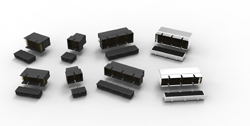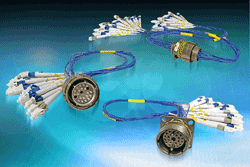Connector makers target portable medical, military equipment
Today’s connectors have to be smaller, lighter, more durable, and able to handle higher speed
BY GINA ROOS
The proliferation of portable medical and military devices, driven in part by healthcare reforms and the emergence of the “networked” soldier, respectively, have tasked connector makers with providing all of the traditional high-reliability features required in these applications including greater durability, higher mating cycles, and quick and easy mating, all housed in a smaller package.
In addition, the need to reduce weight and to handle higher data rates has pushed the industry toward fiber topics, particularly in the military sector. Higher-speed signal transmission and the need to reduce weight is driving the momentum toward fiber optics, and the near potential for embedding active devices into the fiber-optic cabling, said David Gingerich, vice president of engineering and product management, for the Aerospace, Defense & Marine business unit of Tyco Electronics (Harrisburg, PA).
Digital convergence also is becoming a greater design issue, particularly in medical applications. By far, the convergence of technologies — consumer electronics, data communications, and wireless communications — is the biggest trend in the medical sector, said Anthony J. Kalaijakis, strategic medical marketing manager for Molex (Lisle, IL).
“Networking is definitely part of this convergence model when you see things like a cell phone becoming a 'portable nurse' in many applications along with a trend toward telehealth,” added Kalaijakis.
Another part of this convergence is the transfer of digital imaging over high-speed networks. What this means for connector designs is that they have to be smaller, lighter, more durable, and able to handle higher speeds.
This convergence also has led to the move toward modified off-the-shelf components. As an example, microconnectors used in cell phones can be adapted for use on next-generation medical devices. There are still some medical-specific requirements such as the use of all gold plating that is not required on the commercial side but those things will be worked out with some compromised solutions, Kalaijakis said.
Some of the most important factors that designers need to look at when evaluating different connectors for medical applications include operational environment and duty cycle.
Designers also have to look at connectors in terms of modality, said Kalaijakis. “The big iron stuff like the MRI equipment is really driven by image clarity and the ability to manipulate these digital images and transmit them electronically in real-time without any data corruption and in compliance with the HIPPA [Health Insurance Portability and Accountability Act] rules,” Kalaijakis said.
This means it has to be a secure communications with a high performance and high-bandwidth bus line in which the connector plays an important role.
As a result, Molex is looking at adopting its molded interconnect design (MID) technology, used in the antenna business unit, for medical interconnects. Using laser directed structuring (LDS) for 3D plated plastics, this MID approach increases both density and functionality by integrating the traces right in the molded plastic.
Portable MRI scans is another big driver in the medical market, said Gijs Werner, global market manager commercial products, for FCI's Electronics Division (Etters, PA). Medical institutions want to make sure the scans are accurate and precise, which is directly related to the connectors used in this equipment, he said. “They have to transmit at the speed and provide the reliability needed for the equipment.”
Ultrasound and medical imaging equipment makers are also looking at PC standards like PCI Express as the equipment shrinks in size. Werner said it's basically the same equipment but it's cheaper and uses standardized computer connectors and cards.
This also means that many connector systems initially designed for the server industry are being adopted for medical devices. As examples, FCI's HCI connector system and high power edge card (HPCE) connector developed for the server industry is now being adopted in the medical and military arenas. The HCI Connector System provides capability for both power and signal contacts in a single connector to enable power distribution and power control. These connectors use stamped and formed power contacts, initially pioneered by FCI with its PwrBlade system.
The HPCE connector offers a low-profile height, and is based on very cost-effective and highly reliable stamped-and-formed power contact technology, said FCI.
FCI also introduced the MezzoStak 0.5-mm mezzanine connectors for handheld medical and military applications. These devices can operate at high temperature (–40° to 125°C) and withstand high shock and vibrations.
Although many connector makers develop custom or modified custom interconnect systems for high-reliability applications such as medical and military, some suppliers such as ITT Interconnect Solutions (Santa Ana, CA) are developing a number of standard products aimed at these applications.
For example, ITT's “super clean” connectors can be cleaned more than 2500 times in military and medical apps. These miniature and lightweight Nemesis SC connectors feature ITT's Pogo Pin/Pad and breakaway technologies, increasing the number of mating cycles to more than 10,000.
Aimed at medical applications, ITT recently introduced the Nemesis Series and MKJ Series breakaway connectors that incorporate a push/pull mating mechanism to engage and disengage the connector systems. The coupling mechanism uses a canted spring design, which allows for a quick disconnect and ratings of more than 5000 cycles. These can be used in portable medical imaging and diagnostic equipment including field use.
Also for medical diagnostic and imaging equipment including ultrasound, patient monitoring and portable imaging equipment, and MRI machines, ITT's high reliability zero insertion force (ZIF) connectors offer extended life cycles and reduced crosstalk. These connectors feature a minimum rated life of 10,000 complete mating and unmating cycles and can be mated in less than two seconds.
Thinking outside the box
Tyco Electronics' medical products business unit, which is focused on outside-the-box connector solutions, sees a trend in smart connectivity, which includes the integration of RFID particularly for surgical and patient monitoring applications.
There is also a move away from reusable to disposable products, said Marc Socquet, global marketing manager, for Tyco Electronics' medical products business unit (Harrisburg, PA).
The biggest reason for the shift to disposable devices is that it creates a little bit more of razor blade model for revenue, said Joe Glover, director of marketing, for Tyco Electronics' medical products business unit. “Once you have the chassis installed you can sell a number of disposable devices at anywhere between 10 to 20 percent of the cost of the traditional reusable device.”
The second reason is to keep patients from getting re-infected, said Glover. There is a greater chance of patients getting re-infected from a reusable device in a hospital environment than from a disposable one, he said.
And depending on the medical application — surgical, catheter, patient monitoring and ultrasound equipment — the look, the feel and the use of the connector can vary significantly, along with the most important specifications, said Socquet. As an example, in the OR suite audible and tactile feedback is extremely important to ensure that the connector assembly is connected to the right system.
In the surgical sector for reusable devices, durability and functionality are equally important, whereas functionality versus cost is the big issue for disposable products, said Glover. For cart-based ultrasound systems, it's channel count and functionality; for handhelds it's smaller size and as high a channel count as possible, and for patient monitoring it's durability and cost, he added.
Military needs speed without sacrificing reliability
Similar to the mobile communications market, the military market also is calling for rugged, smaller interconnects that can handle faster data rates. One of the most recent from ITT is the 1.0-mm-pitch NANO D series. The D-style connector is well suited for use on the PCB or in a panel-mount environment where space is limited, said Wes Morgan, director, Americas Product Management, for ITT Interconnect Solutions (Santa Ana, CA).

ITT's NANO D connector meets military applications that require faster data rate handling capability in a tiny package.
Interfaces are also being designed to handle high-speed Ethernet connections, such as ITT’s Quadrax contacts that also come in high-reliability packages. These devices can be used in trains, ships, and in military applications that call for high-speed data for imaging systems.

Tyco Electronics' FORTIS ZD high-speed backplane connectors allow 10 Gbits/s data rates in the most demanding military and commercial aerospace applications.
Tyco Electronics designed its FORTIS ZD high-speed backplane connector for military and commercial aerospace applications, aimed at handling multi-gigabit data rates in harsh environments. The connector maker said by combining the best features of commercial high-speed backplane connectors with proven mil-spec contacts, the ruggedized connector can handle data rates of 10 Gbits/s.
Durability, cycle life, insertion/extraction force, and easy terminations in the field are all important but what really separates these military connectors is their robustness in harsh environments, said Gingerich. “You cannot sacrifice reliability in either military or aerospace applications.”
One of the greatest demands for high-quality video is unmanned aerial vehicles (UAVs), which is driving the requirement for high bandwidth together with higher electrical performance so the systems have longer lives. This is expected to lead to a greater shift to fiber optics over the next few years.
“The UAV world is the fastest growing sector in the military and every gram is important so lightweight and performance are the driving factors. And the management of all these sensor inputs is one of the driving factors for speed in these systems,” said Benjamin Jeffrey, group manager, industry marketing, for Molex.
There are also a number of initiatives underway to network the individual soldier, which will call for very rugged and very lightweight interconnects, said Jeffrey.
Similar to the medical sector, commercial off-the-shelf (COTS) parts are being used in military applications. The COTS movement has made it so much easier than it would have been 15 years ago to use commercial-based products in these systems, said Jeffrey.
It also lowers the cost. As an example, Molex offers a backplane connector that is used by several large telecom OEMs, which has been adopted for military communications applications. With a larger base of business, it makes it much more economical, said Jeffrey.

ITT's PHD 38999 Series connectors, originally designed for telecom apps, offer a variety of circular and rectangular MIL specification and standard connector configurations.
For example, ITT's PHD 38999 Series of fiber-optic connectors, which were initially developed for high-speed backplane systems in telecom switching applications, are being used in military, aerospace and tactical communications applications.
One reason why the military is moving away from some mil-specs to industry-standard parts is that the specs are out of date. There hasn't been a backplane spec, for example, written for the military in 15 to 20 years, said Jeffrey. The military now uses the VITA specs as the baseline.
Morgan's advice to military product designers is to keep in mind the alignment between commercial and military specs because the parts will be able to operate in both worlds and it will help keep pricing in line.
Also, making sure they have the right specs for the right applications is key, said Morgan. “If designers strictly adopt mil-spec criteria they may be foregoing the benefits of current state-of-the-art technology.”
Another design challenge is meeting environmental initiatives including the European Union's Restriction of Hazardous Substances (RoHS) directive. Initially launched about five years ago, RoHS called for the elimination of lead, mercury, cadmium, hexavalent chromium, polybrominated biphenyls (PBB), and polybrominated diphenyl ethers (PBDE) in electronics products.
In the military sector, the big fear is still the issue of tin whiskers with pure tin finishes, but the products are getting better in terms of performing well with lead-free solders, said Jeffrey. Tin whisker growth has been linked to failures in electronics.
ITT has developed an alternative plating — black zinc nickel — that is both RoHS compliant and meets all of the corrosion requirements under mil-spec. The plating lines have been validated and are available as a standard offering for a number of ITT's mil-spec and non-mil-spec products.
Advertisement
Learn more about FCI ElectronicsITT Interconnect SolutionsMolexTE Connectivity





